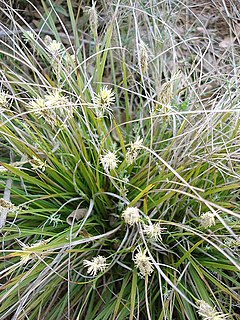
Carex is a vast genus of more than 2,000 species of grass-like plants in the family Cyperaceae, commonly known as sedges. Other members of the family Cyperaceae are also called sedges, however those of genus Carex may be called true sedges, and it is the most species-rich genus in the family. The study of Carex is known as caricology.
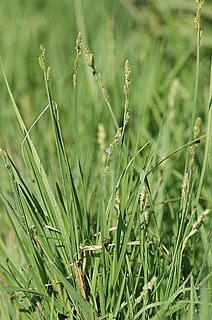
Carex canescens L. is a perennial species of plants in the family Cyperaceae growing in damp forests and wetlands. It is widespread across much of Europe, Asia, Australia, New Guinea, North America, Greenland and southern South America.

Carex vesicaria is an essentially Holarctic species of sedge known as bladder sedge, inflated sedge, and blister sedge. It has been used to insulate footwear in Norway and among the Sami people, and for basketry in North America.

Elachista utonella is a moth of the family Elachistidae found in Asia and Europe.
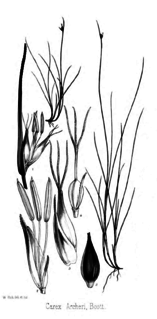
Carex archeri, known as Archer's sedge, is a species of sedge in the genus Carex, endemic to south-eastern Australia.
Carex vicinalis is a species of sedge that was first described by Francis Boott in 1867. It is native to southern India. The type specimen was collected at the Nilghiri Hills.
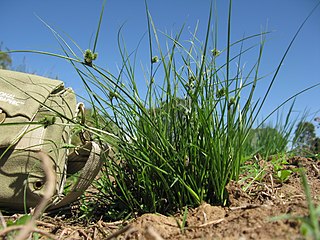
Carex inversa, commonly known as knob sedge, is a species of sedge of the family Cyperaceae that is native to parts of Australia and New Zealand and has also been introduced into Great Britain.

Carex siccata, common names including dryspike sedge, is a species of Carex native to North America. It is listed as endangered in New Jersey. As of May 2021, USDA Plants regards Carex foenea as a synonym of C. siccata, whereas the World Checklist of Selected Plant Families regards only two varieties of C. foenea as synonyms, treating C. foenea itself as a separate species.
Carex foenea is a species of flowering plant in the family Cyperaceae, native from subarctic America to the northern United States. It was first described by Carl Ludwig Willdenow in 1809.

Carex bromoides, known as brome-like sedge, brome-sedge, and dropseed of the woods, is a species of sedge in the genus Carex. It is native to North America.

Carex bicknellii, known as Bicknell's sedge and copper-shouldered oval sedge, is a species of sedge native to North America. Carex bicknellii grows in small clumps with fewer than 25 flowering stems per clump. It is found in mesic to dry prairies, savannas, and open woodlands.

Carex bebbii, Bebb's sedge, is a species of sedge native to the northern United States and Canada. Carex bebbii grows in a variety of wetland habitats such as lakeshores, streambanks, ditches, meadows, swamps, and seeps. It forms dense tufts with culms up to 90 centimeters tall.

Carex tenera, known as quill sedge, is a species of sedge native to the northern United States and Canada.
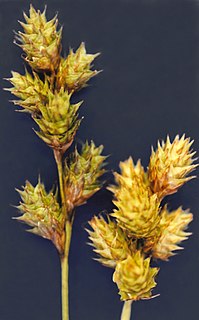
Carex brevior, known as shortbeak sedge and plains oval sedge, is a species of sedge native to North America. The specific epithet brevior means "shorter" in Latin.
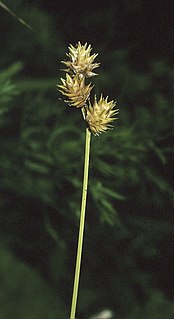
Carex straminea, known as eastern straw sedge, is a species of sedge native to North America.
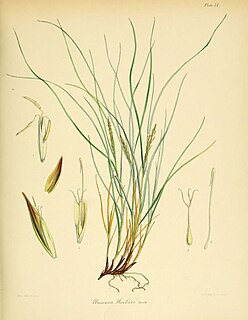
Carex erebus is a member of the sedge family and is found on the Antarctic Islands of Australia and New Zealand.

Carex divulsa, the grey sedge, is a species of flowering plant in the genus Carex, native to Macaronesia, Europe, northwest Africa, the Caucasus region, and the Middle East as far east as Turkmenistan. It has been introduced to northeast Argentina, the District of Columbia and Pennsylvania in the United States, Ontario in Canada, the North Island of New Zealand, and Tasmania and Victoria in Australia. It is the namesake of the Carex divulsa aggregate.
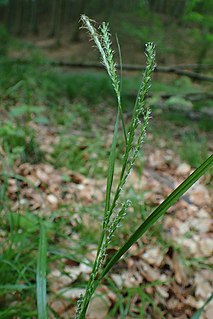
Carex strigosa, the thin-spiked wood sedge, is a species of flowering plant in the genus Carex, native to Europe and the Caucasus region. Its diploid chromosome number is 2n=66.
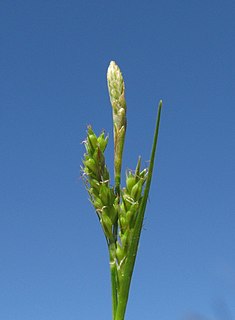
Carex breviculmis, called the Asian shortstem sedge, is a species of flowering plant in the genus Carex, native to Asia from the Indian subcontinent to Southeast Asia, China, Taiwan, Korea, Japan, north as far as Khabarovsk Krai, and Malesia, New Guinea, Australia, Norfolk Island and New Zealand. It has been introduced to the US state of Mississippi. Typically found in forests, it is quite shade tolerant.
Carex tasmanica, called curly sedge, is a species of flowering plant in the family Cyperaceae, native to Victoria and Tasmania states in Australia. It gets its common name from the distinctive helical spirals its leaves form when they dry out. Considered a threatened species, none of its populations are in a protected area.

















